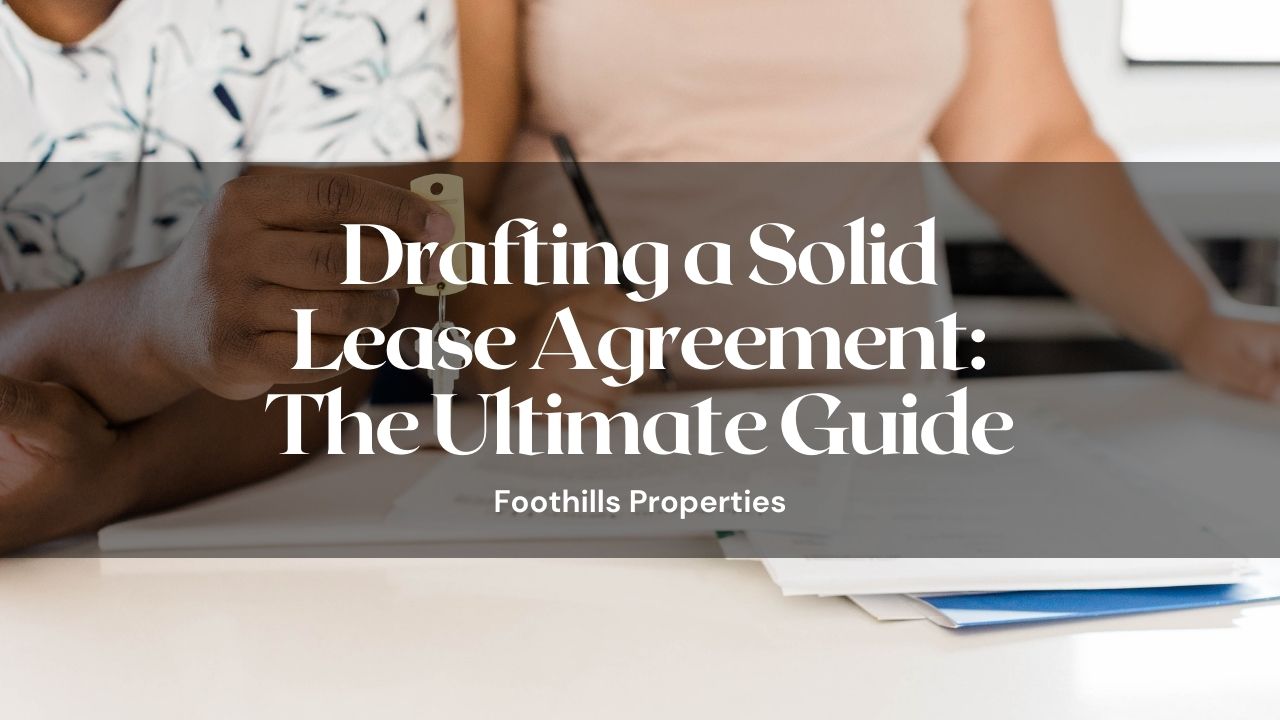
One responsibility that landlords have is being able to draft a legal lease agreement. A good lease is one that defines your expectations as a landlord as clearly as possible.
Remember, you can’t penalize your tenant for something they know nothing about. For example, if you don’t have a clause on subletting, how will your tenant know that they need your permission to do so?
The following is a guide by Foothills Properties Management & Realty that will help you when making a solid lease agreement for your rental property. You should include these clauses to avoid confusion or misunderstanding later down the line.
1. The Lease Term
Most landlords might think that their tenants know when their lease will expire. This can be a costly mistake if the tenancy’s term is not clearly outlined in the rental agreement.
Getting stuck with a holdover tenant can make a huge impact on your investment. That’s because to get rid of them, you’ll need to undergo the statewide tenant eviction process. And as you probably know, this can be stressful, lengthy, and costly.
So, ensure you have a clause on the term of the lease in your agreement. Broadly speaking, you have two options in this regard. You can either choose a short-term lease or a long-term lease.
A short-term lease runs anywhere between a week to a few months, whereas a long-term lease runs anywhere from six months to a year.

2. The Names of All Adult Tenants
Include all the names of all adult tenants living in your rental property in your lease agreement. Often, most landlords make the mistake of only including the names of the person they are signing the lease with.
You see, leaving out the names of other adult tenants means you’ll not be able to hold them accountable for adhering to the terms of the lease. What happens if the tenant on the lease fails to pay rent, for example? In such a case, you may not have any legal means to require it from the others.
3. Limits of Occupancy
Another clause you’ll not want to leave out from your lease is the occupancy limits. How you define it will depend on whether you’ll allow subletting or not.
If you allow subletting, then make sure you state that in your requirements.
For example:
- Require that the tenant seek your permission first before subletting their unit.
- State the amount of time a tenant must have rented your unit before seeking to find a sublet. This can be a great way to incentivize a great tenant.
- State that you reserve the right to approve or reject a sublet. This will ensure that only tenants you have screened get to live in your unit.
But if you don’t allow it, then make sure to state it in the agreement – as well. You may even want to let your tenant know the repercussions of doing so against your will.
4. Rules of Entry
Tenants have an implied right to privacy once they move into a property they are renting. Basically, this means that even as a landlord, you cannot enter your tenant’s premises just to check up on them. If you continue to do this, your tenant could sue you for landlord harassment.
According to Arizona landlord-tenant law, landlords must provide their tenants a notice of at least 48 hours prior to entry. You must also have a good reason to enter your tenant’s premises.
Such reasons include:
- When given permission by tenants.
- In case of an emergency.
- To make needed or required improvements.
- To show the unit to prospective tenants, lenders, or buyers.
- In case of property abandonment by the tenant.

5. Landlord & Renter’s Rights
Your lease agreement must also state the rights each party has to the lease.
Common renters’ rights in Arizona include the right to:
- Live in a habitable rental property.
- Live in the quiet and peaceful enjoyment of their rented premises.
- Be treated with respect and fairness.
- Continue living in their rented premises until the proper eviction procedure is followed.
When it comes to landlords, the lease gives you the following rights:
- Enter rented premises to carry out important responsibilities.
- Enforce the terms of the lease agreement.
- Evict a tenant for gross violation of the lease agreement.
- Make changes to the lease agreement with the consent of the tenant.
6. Landlord & Tenant’s Responsibilities
Landlords and tenants in Arizona both have responsibilities they need to adhere to, in addition to the rights mentioned prior.
Renters in Arizona have the following responsibilities:
- Ensure the property is always clean.
- Abide by all terms of the lease agreement, including paying rent on time.
- Move out when their lease terms end.
- Notify the landlord when maintenance issues crop up.
As for landlords, common responsibilities include:
- Respond to maintenance issues on time.
- Maintain all common areas.
- Abide by the terms of the lease agreement. For example, when raising the rent amount.
- Notify the tenant when looking to access their premises.
- Comply with all requirements of applicable building codes materially affecting the safety and health of tenants.

7. Further Rules About Rent
Besides the amount of security deposit, your lease should also be upfront on rent-related matters. Just telling your tenant how much rent they need to pay and stopping there can be a genesis of problems.
The following are other rent-related things your lease should mention:
- How tenants should pay rent. Common options include by check, money order, or online via a portal.
- The amount of grace period. Under the Arizona Residential Act, there is no statutory grace period. You can, however, mention it on the lease agreement.
- Rules regarding late fees. Clarify the amount and terms.
- Where rent is due. For instance, your office’s business address.
8. Rules Regarding Pets
This is another clause that your lease agreement shouldn’t miss on. Just like subletting, if you allow pets, then make sure to mention that in your lease. And if you don’t allow them, do so, as well.
The Bottom Line
There you have it, 8 clauses that every lease or rental agreement should have. Remember, though, a lease can only be enforceable if it’s legal. So, once you’ve drafted it, make sure to have a professional double-check it.
For more assistance drafting solid lease agreements, contact the experienced team at Foothills Properties Management & Realty today!








